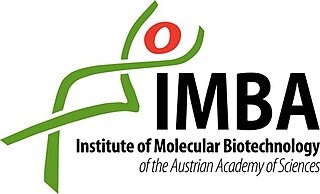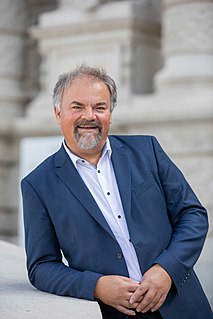Related Research Articles

Regulation of gene expression, or gene regulation, includes a wide range of mechanisms that are used by cells to increase or decrease the production of specific gene products. Sophisticated programs of gene expression are widely observed in biology, for example to trigger developmental pathways, respond to environmental stimuli, or adapt to new food sources. Virtually any step of gene expression can be modulated, from transcriptional initiation, to RNA processing, and to the post-translational modification of a protein. Often, one gene regulator controls another, and so on, in a gene regulatory network.

A primary transcript is the single-stranded ribonucleic acid (RNA) product synthesized by transcription of DNA, and processed to yield various mature RNA products such as mRNAs, tRNAs, and rRNAs. The primary transcripts designated to be mRNAs are modified in preparation for translation. For example, a precursor mRNA (pre-mRNA) is a type of primary transcript that becomes a messenger RNA (mRNA) after processing.

Protein odd-skipped-related 1 is a transcription factor that in humans is encoded by the OSR1 gene. The OSR1 and OSR2 transcription factors participate in the normal development of body parts such as the kidney.

Matthias Werner Hentze is a German scientist. He is the Director of the European Molecular Biology Laboratory (EMBL) and Professor of Molecular Medicine at Heidelberg University.

The Institute of Molecular Biotechnology (IMBA) is an independent biomedical research organisation founded by the Austrian Academy of Sciences in cooperation with the pharmaceutical company Boehringer Ingelheim. The institute employs around 220 people from over 40 countries, who perform basic research. The IMBA operates in close collaboration with the Research Institute of Molecular Pathology (IMP), the basic research center of Boehringer Ingelheim. Both institutes are located next to each other at the Vienna Biocenter (VBC).

Chromatin immunoprecipitation (ChIP) is a type of immunoprecipitation experimental technique used to investigate the interaction between proteins and DNA in the cell. It aims to determine whether specific proteins are associated with specific genomic regions, such as transcription factors on promoters or other DNA binding sites, and possibly defining cistromes. ChIP also aims to determine the specific location in the genome that various histone modifications are associated with, indicating the target of the histone modifiers.

In molecular biology bantam microRNA is a short RNA molecule. MicroRNAs function to regulate the expression levels of other genes by several mechanisms.
In molecular biology mir-430 microRNA is a short RNA molecule. MicroRNAs function to regulate the expression levels of other genes by several mechanisms.

Thomas Jenuwein is a German scientist working in the fields of epigenetics, chromatin biology, gene regulation and genome function.

Barry J. Dickson is an Australian neurobiologist who studies the development of neuronal networks in the fruit fly Drosophila melanogaster. Dickson is a group leader at the Janelia Research Campus of the Howard Hughes Medical Institute in Loudoun County, Virginia and a former scientific director of the Research Institute of Molecular Pathology (IMP) in Vienna, Austria.
Hartmut Beug (1945–2011) was a German cancer biologist who studied how groups of oncogenes interact to lead to the development and spread of cancer. Shortly before his death, a foundation was set up in his and his wife’s name to support collaboration among young scientists and their studies in the field of metastasis.

Erwin Friedrich Wagner is an Austrian biochemist known for his research on the molecular basis of cancer and associated conditions such as inflammation and cachexia. He was Deputy Director of the Spanish National Cancer Research Center (CNIO) in Madrid, Spain until 2019. Since 2019, Wagner is a group leader affiliated with the Medical University of Vienna.

Denise P. Barlow was a British geneticist who worked in the field of epigenomics. Barlow was an elected member of European Molecular Biology Organization (EMBO), an honorary professor of genetics at the University of Vienna and recipient of the Erwin Schrödinger Prize of the Austrian Academy of Sciences. In 1991, she discovered the first mammalian imprinted gene, IGF2R, which codes for the insulin-like growth factor.
Jan-Michael Peters is a cell- and molecular biologist. Since 2013, he is Scientific Director of the Research Institute of Molecular Pathology (IMP) in Vienna.
Antonio Jesus Giraldez is a Spanish developmental biologist and RNA researcher at Yale University School of Medicine, where he serves as chair of the department of genetics and Fergus F. Wallace Professor of Genetics. He is also affiliated with the Yale Cancer Center and the Yale Stem Cell Center.
Meinrad Busslinger is a biochemist and immunologist, renown for his work on B cells. He is a Senior Scientist and Scientific Deputy Director of the Research Institute of Molecular Pathology (IMP) in Vienna, Austria.

Jürgen Knoblich is a German molecular biologist. Since 2018, he is Scientific Director of the Institute of Molecular Biotechnology (IMBA) of the Austrian Academy of Sciences in Vienna.
Julius Brennecke is a German molecular biologist and geneticist. He is a Senior Group Leader at the Institute of Molecular Biotechnology. (IMBA) of the Austrian Academy of Sciences in Vienna.

Moshe Yaniv, born in 1938 in Hadera, Israel, is a French-Israeli molecular biologist who has studied the structure and functions of oncogenic DNA viruses as well as the general mechanisms for regulating gene expression in higher organisms and their deregulation during tumor pathologies and development. He is a member of the French Academy of sciences and Professor Emeritus at the Institut Pasteur.
Eileen E. M. Furlong is an Irish molecular biologist working in the fields of transcription, chromatin biology, developmental biology and genomics. She is known for her work in understanding how the genome is regulated, in particular to how developmental enhancers function, how they interact within three dimensional chromatin topologies and how they drive cell fate decisions during embryogenesis. She is Head of the Department of Genome Biology at the European Molecular Biology Laboratory (EMBL). Furlong was elected a member of the European Molecular Biology Organization (EMBO) in 2013, the Academia Europaea in 2016 and to EMBO’s research council in 2018.
References
- 1 2 3 "Alexander Stark - Systems biology of regulatory motifs & networks". The Research Institute of Molecular Pathology. Retrieved 2018-02-11.
- 1 2 "Alexander Stark". Research Institute of Molecular Pathology GmbH. IMP. Retrieved 2019-02-14.
- 1 2 3 4 "Alexander Stark". Stark Lab. Research Institute of Molecular Pathology. Retrieved 11 March 2019.
- ↑ https://www.imp.ac.at/fileadmin/content/About_IMP/Research_Reports/2008_IMP_Research_Report.pdf
- ↑ https://www.imp.ac.at/fileadmin/content/IMP_ResearchReport.pdf
- ↑ "Deciphering the transcriptional cis-regulatory code". Stark Lab. 2018-02-05. Retrieved 2018-02-11.
- ↑ Brennecke J, Stark A, Russell RB, Cohen SM (2005) Principles of MicroRNA–Target Recognition. PLoS Biol 3(3): e85. https://doi.org/10.1371/journal.pbio.0030085
- ↑ Brennecke, Julius (4 April 2003). "bantam Encodes a Developmentally Regulated microRNA that Controls Cell Proliferation and Regulates the Proapoptotic Gene hid in Drosophila". Cell. 113 (1): 25–36. doi: 10.1016/S0092-8674(03)00231-9 . PMID 12679032. S2CID 17585984.
- ↑ Heintzman, Nathaniel (7 May 2009). "Histone modifications at human enhancers reflect global cell-type-specific gene expression". Nature. 459 (7243): 108–112. Bibcode:2009Natur.459..108H. doi:10.1038/nature07829. PMC 2910248 . PMID 19295514.
- ↑ "Find a Young Investigator". EMBO.
- ↑ Pathology, The Research Institute of Molecular. "Alexander Stark among the world's most highly cited researchers".
- ↑ Pathology, The Research Institute of Molecular. "Press Release: EMBO Accolade for Alexander Stark".
- ↑ "Find a Member". EMBO.
- ↑ "IMP Scientist Alex Stark awarded an ERC Consolidator Grant". idw-online.de.
- ↑ "Genes & Development -- About the Journal". genesdev.cshlp.org.
- ↑ "Editors & Board - Molecular Systems Biology". msb.embopress.org.